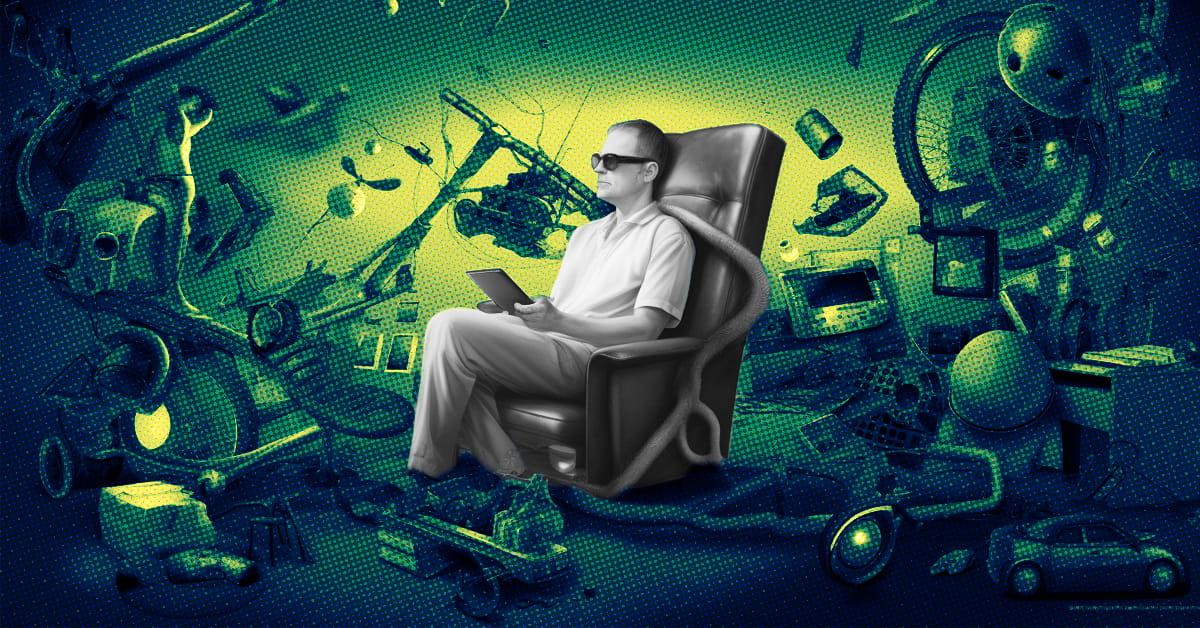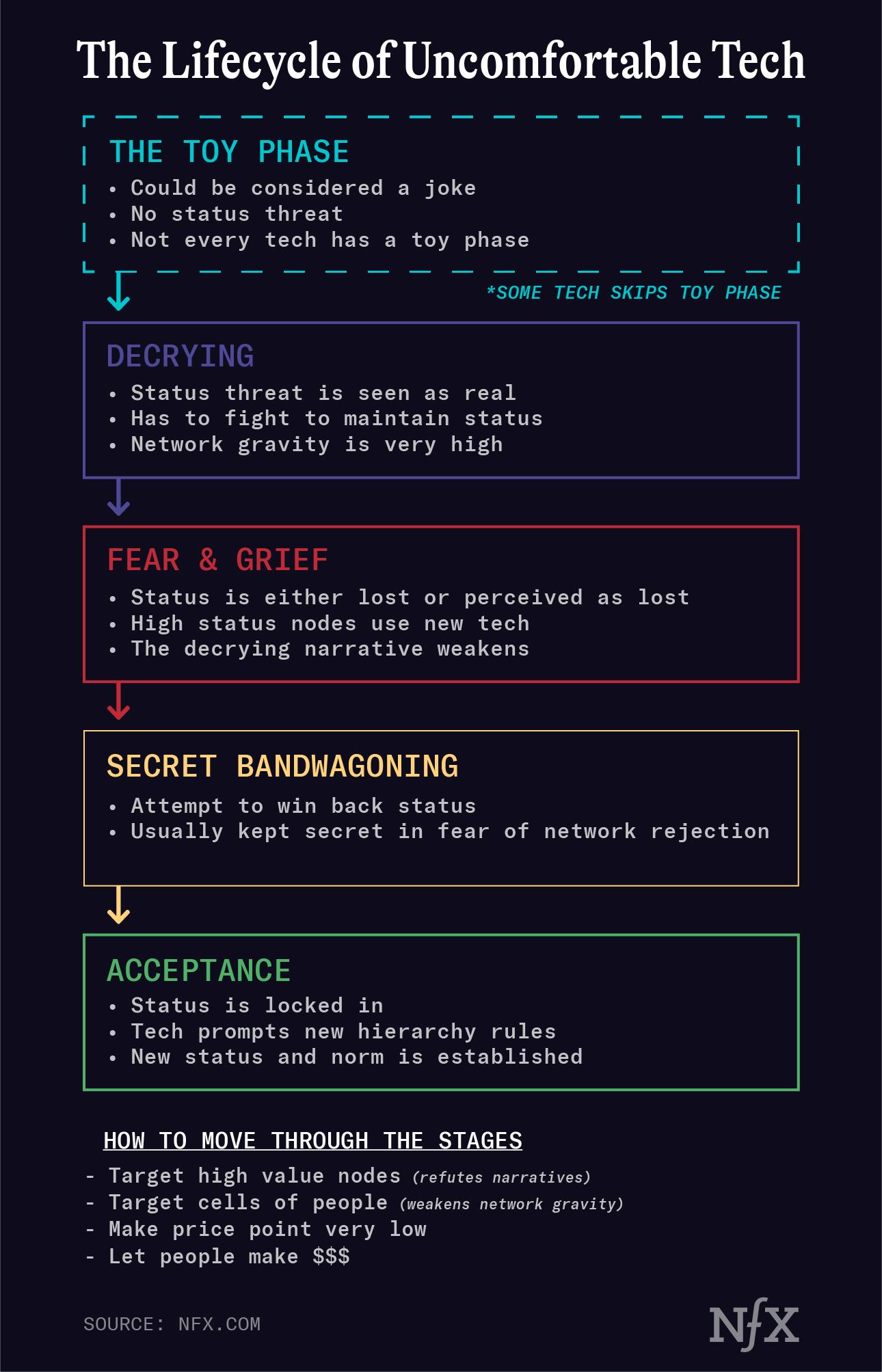

With the rise of Generative Tech, we are in for a frenzy of newness. It could make some groups of people uncomfortable for the next 2-3 years.
But eventually, they will realize that the technology lets them do more and better. They will adapt and thrive, as they have in so many technology waves of the past.
The founders and creators that win during tech shifts like the one we’re seeing with Generative Tech learn how to navigate it in each phase of the lifecycle, so it’s worth breaking it down.
******
Not long ago it felt risky and uncomfortable to plug your credit card into a website, to use your real name on social media, own Bitcoin, ride in an Uber, stay in an AirBnB, or host a Zoom meeting from your bedroom. Before that, technologies triggering fear responses included the lightbulb (“unworthy of attention”), the automobile (“just give us faster horses”), talking movies (“talking doesn’t belong in pictures”), airplanes (“emotion has run away with reason”).
Most big tech revolutions bring with it a wave of fear that people will lose their jobs to machines, robots and AI, as typified by the Luddites in England in the 1810s, and by the thinking of documentaries like “Humans Need Not Apply” from 2014.
I know it always “feels different this time.” But it turns out that the lifecycle of uncomfortable tech repeats itself, and that the stages are predictable if you take the time to look.
Consensus for some; resistance for others: Why is that?
We wrote in Generative Tech Begins that the belief in Generative Tech is already consensus. “Everyone is on board with Generative Tech. The VCs get it. The Founders get it. The incumbents get it. And it’s clear that the game is now on.”
So the people who are driving Generative Tech forward are all in agreement. But we’re at the point in the cycle where the mainstream adopters are not on board. Not yet.
It’s important for you, the founders building leading edge technologies, to understand why that is. In order to grow your businesses, you will need to reach people who are not like you.
The people who feel uncomfortable with your new technology are the “early majority” in the classic Technology Adoption Lifecycle. They’re on the distant, other side of the chasm from you, and they’re beginning to learn about Generative Tech and really just beginning to grapple with concerns about potential changes to their status in the network. This not only includes visual artists, musicians and writers, but also includes paralegals, investment bankers, analysts, software programmers, venture capitalists and more.
This can feel counterintuitive. You might expect that musicians would be thrilled about AI-generated music, photographers thrilled about Infinite Nature, that writers would be thrilled about AI-generated content. It solves a zero-to-one problem they deal with every day. Shouldn’t they all be excited? They’re getting help! Their jobs are easier! They’re getting new creative ideas. They can use higher brain power on other things. Or free up a few hours to learn how to cook or coach a soccer team.
Still, this is now uncomfortable tech. In a recent WIRED piece, our friend Kevin Kelly wrote that Generative Tech is fostering a feeling among creatives that “Wait, it works too well. Do something!”
What’s causing that reaction? Sure, as most say, it’s often the fear of losing income, but I would argue the greater insight is that it’s more a fear of losing status.
Status Attack
Where we are in this Generative Tech lifecycle reminded me of a dinner I had with my stepmother years ago. She’s a professional musician, so to do a nice thing and turn the conversation around the dinner table toward her and her area of expertise, I asked: “Hey, what if we reinvented the musical notation system? How could we make it better if we were to start from scratch today?”
It was the worst dinner I ever had with her. The idea of a new musical notation system threatened her mastery of the old system, her worth in the industry, and her years of hard work.
These threats cut deep because they trigger a perceived loss of status.
As pack animals, human beings are constantly trying to establish their position in a hierarchy. The creation of a new technology often means that the rules of that hierarchy are about to change. You now run the risk of moving from the top to the bottom of the heap.
This fear of technology-induced status loss has always existed, but in the last 50 years, we have faced it more frequently than our ancestors.
Today, for an artist, if Dall-E can “draw” anything imaginable in seconds, then what skills make an artist valuable? Attention to detail? Style? Imagination? Irreverence? Branding? Origin story? Personal life drama?
Starting today, the ability to write a unique text prompt to generate an output from an AI is the skill that produces interesting visual art in minutes. Is that art? This was the question raised in an art competition in Colorado, where a game designer using MidJourney won first prize. The only thing he wouldn’t reveal about his process: the words he used to prompt the prize-winning image.
The unsaid rules of what it took to win this art competition changed. What the system values changed. You may experience a loss of status as you learn (or don’t learn) those new rules of the game.
The fear of status loss drives backlash against new technology. It’s why we find new technologies uncomfortable.
Productivity Increase, or Revolution?
If you have a technology that increases your productivity by 20%, that’s not uncomfortable. Everyone sees it as progress, and it’s welcomed. It makes you look good to your boss or customers because it moves you along the spectrum of productivity, but keeps you in the exact same role and status relationship to the other people in your networks.
But if a tool gives you 100% bonus output, you’ve basically twinned yourself, and the math means others begin to question your relative position and value. (For an entertaining illustration of this, we can recommend the 2011 Rebel Flesh episode of Dr. Who.)
Last week I got an email from a writer who is worried about her profession. The generative writing tools on top of Stability and GPT3 are a little too good.
Generative Tech is pushing beyond normal productivity math, threatening to increase quality and output of some people by 200% or more.
You used to have a stable production and consumption pattern, but this tech breaks that pattern. It breaks the math of the existing network. That’s uncomfortable.
That’s another reason why fundamentally transformative tech – like AI, like farm combines of the 1800s – may spark concern rather than delight in the early majority.
The Lifecycle of Uncomfortable Tech
The psychological journey faced by the early majority happens in five phases. It’s crucial to understand that this isn’t just a cycle of fear. Most people eventually adopt these new technologies – they just have to go through this process first.
1. The Toy Phase.
2. The Decrying Phase.
3. The Grief and Fear Phase.
4. The Secret Bandwagon Phase.
5. The Accept & Accelerate Phase.


Let’s look at each phase.
1. The Toy Phase
Some uncomfortable technologies begin as toys.
Blue Mountain Arts was the first real social media company in 1996. On their website, you could rearrange elements of the 1000’s of digital greeting cards and send them to another person. It was fun to play with.
Snap started with teenagers sending each other lewd but disappearing images. TikTok started as Musical.ly with teens copying each other’s dance videos. In the early days of Lyft, it was funny to look for the furry pink mustaches.
Few people take something too seriously when it’s in the toy phase, because all but very few see these technologies as valuable.
Technologies that begin their lives as toys will go through a shift in which they suddenly become threatening. This happens when people start using those toys to gain an advantage – now it’s threatening your social status and perhaps income.
2. The Decrying Phase
You know you’ve left the toy phase when the backlash starts. These negative narratives usually come in three types:
It’s Low Status – When online dating first began in the late nineties and early 2000s, the implication was that only losers would date online. The new technology was pegged as low status – something to hide.
It’s Dangerous – It was once considered dangerous to pay with a credit card online. It was considered dangerous to stay in an AirBnb or ride in an Uber. There’s also a more vague part of this narrative which will emerge about 10-20 years from now, and that is nostalgia-driven reminiscing about how we have lost so much good because of this technology. The takeaway is the same: it’s long-term dangerous for society.
It’s Immoral – The immorality narrative appeals to the idea that what’s right and fair today should continue to always be right and fair. As we highlighted in this essaythis article “The Economics of Creativity: Who Gets Paid and Why,” musicians like Billy Bragg, whose music was included by fans on social networks in the 2000’s, felt is wasn’t right or fair that they weren’t paid for their music while the founders of the new technologies, social networks at that time, made $100M’s.
The more people in your network feel individually threatened by this technology and dig in their heels, the more you are going to hear these narratives. The more your network fights the new technology, the more social resistance you will get from friends and acquaintances if you try to embrace it. This is network gravity at work.
The emergence of this network gravity is the hallmark of the decrying stage. It is also one of the first places where, as a founder, you’ll have to use network effects to combat the strength of this gravity.
Information is necessary but not sufficient. You can teach people about the blockchain, or explain that not everyone on a dating app is a loser. But information falls flat when confronted with fear and yelling. These narratives aren’t logical – they’re emotional.
Vaccines provide a good illustration. The best way to convince someone to get a vaccine isn’t to relay the science. It’s to show them that someone in their network, someone they idolize, or identify with, has gotten the vaccine.
It’s network wars. To counter the network gravity of those decrying the tech, you need to reach and activate key, high status nodes. Create a network of people to combat the decriers.
You need to know that a friend plugged their credit card information into Amazon, and wasn’t defrauded. You need to go to the wedding of a power couple who met on a dating app. You need to see that a story written with GPT-3 was published by The New York Times.
Think about what factors confer status in this network (wealth, Twitter followers, prestige, a feeling of “authenticity”), and which nodes are particularly influential. These nodes will help reduce the strength of network gravity. This essay lays out the tactics, “Network Bonding Theory.”
3. The Fear and Grief Phase
Once decriers begin to see high status nodes using the new thing, they might start to panic. The decrying narratives no longer hold much sway. They begin to fear that they’ll be left behind.
Once they see your brother hosting Airbnb guests (strangers) in his downstairs studio and earning a second income from it, they start to wonder: why didn’t I do that? In that moment, they had to face the fact that their brother saw something they didn’t. The moral high ground they tried to occupy during the decrying stage evaporates. They enter the stage of grief.
There’s only one way out of that grief. To get in.
4. The Secret Bandwagoning Phase
Fear eventually drives action. They realize they need to jump on the bandwagon – or risk losing their place.
Here is where we begin to see social network effects working in favor of your new technology. It is an inflection point where network gravity can start to work for you, rather than against you.
This is often where a Bandwagon network effect can take hold. People will flock to the new thing slowly at first. But that rate will accelerate as others fear being left behind.
There is one subtlety to this bandwagoning: in the early stages, many new converts may want to keep their use of the tech a secret, out of fear that their old networks will reject them. Many might want to keep it a secret while they reap the productivity gains of the new tool.
Nodes in this phase are not evangelizers. They’re not the first people to join the dancing guy at the music festival as shown in the above video. They’re the folks who join out of fear or missing out. Which means they still have a fundamental fear that they’re going to be rejected by their networks or experience a big status drop.
5. The Acceptance Phase
Eventually, a new network gravity will build completely in favor of the technology. Dating apps took off in 2003 after 5 years of very low growth. Ecommerce took off in 2004 after 8 years of low growth. Real name social networks took off in 2006 after 4 years of low growth. You know you’ve reached the acceptance phase because of the geometric growth in users.
Moving Through the Cycle
Moving through the phases of uncomfortable technology is mostly a matter of helping people see how they maintain or improve their social status with the technology. In many cases, you also want to show them how to make more money, or make money in a way they enjoy more.
In some cases, you may have to wait for market and cultural sentiment to catch up. In other cases, you can drive it forward by what you do.
To drive it forward, there are two main strategies: Social Status and Financial Incentives.
Social Status:
- Target High Value Nodes. As we mentioned before, people need to see those they trust using this tool. Bring key nodes into the network and make them visible in the product, in your PR, and in your social media. They don’t have to be super expensive and famous to be key nodes.
- Target Clusters of People: Sell to teams of people who know each other already rather than to individuals. This eliminates the force of network gravity by making your users part of a cohort. They’re in it together, and may face less social stigma from their immediate networks. You can give them pride in being on the vanguard, together.
Financial Strategies:
Financial advantage offers a clear incentive to evolve. There are many types of “currency” within networks, but dollars are universal.
- Make the price point so low that it’s simply irresponsible not to use the new tech.
- Let new people make money with it. Uber/Lyft/Didi helped millions of people make substantial income who weren’t making money driving before. That spread the new behavior. And it turns out, the financial benefit to these people was exactly how these companies defended themselves from the network gravity of the taxi lobbies and city planners who didn’t like the new thing and tried to stop it.
Where Are We Now?
Right now, for many, the rise of Generative Tech is in the first 1 or 2 phases of The Lifecycle of Uncomfortable Tech. Somewhere between the Toy Phase and The Decrying Phase.
The founders that win understand the psychological drivers in the Lifecycle of Uncomfortable Tech. Then, they’ll use these tactics to build new, more powerful networks with themselves at the core. These are the people who will soon make creative human-machine collaboration feel as normal and ubiquitous as taking an Uber, online dating, or using your credit card online feel today.
As Founders ourselves, we respect your time. That’s why we built BriefLink, a new software tool that minimizes the upfront time of getting the VC meeting. Simply tell us about your company in 9 easy questions, and you’ll hear from us if it’s a fit.


